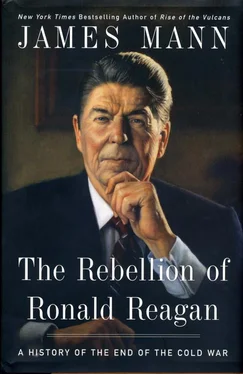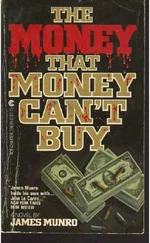American officials were increasingly dismayed. “The West Germans were spending a lot of time cuddling up to the East Germans, to Honecker,” said Nelson Ledsky, who served as the U.S. minister in West Berlin until 1985 and later worked as a European specialist on Reagan’s National Security Council. John C. Kornblum, who succeeded Ledsky in West Berlin, maintained in an interview years later, “At this point in German history, the West Germans had basically given up on reunification. And they were trying to arrange themselves with the East.” 23
Gradually, by late 1986, the top American officials dealing with West Germany decided the United States needed to do something dramatic to arrest the drift toward accommodation and mutual acceptance between the two Germanys. “There was a German attitude that we have to live with the Wall,” asserted Richard Burt, who served as Reagan’s ambassador to West Germany. “They thought, ‘We have to find little ways to come together.’ And their idea of ‘little ways’ was mostly ways to pump deutschmarks into the East to buy off the East Germans.” By late 1986 and early 1987, Burt said, American officials came to the conclusion that “it was incumbent upon us to remind the West Germans that this was still a divided country.” 24
Ronald Reagan was not paying attention to Germany during the first months of 1987. Neither were his domestic advisers or his White House staff. All of them were trying to save his presidency from collapse.
The Iran-Contra scandal had burst open in November 1986. The revelations that the administration had secretly supplied arms to Iran and then used the profits for rebel forces in Nicaragua prompted a series of investigations without parallel since Watergate. Attorney General Edwin Meese conducted a limited inquiry, then a special commission headed by Senator John Tower carried out a three-month policy review, and eventually a special prosecutor, Lawrence Walsh, conducted an extensive criminal investigation. Congress, meanwhile, set up its own joint committee to examine the affair. For months the press was full of suggestions that Reagan might be impeached or forced to resign, as Richard Nixon had twelve years earlier.
The Reagan administration was in turmoil. Several of its top officials either were fired or resigned. National Security Adviser John Poindexter was quickly ousted along with Oliver North, the central operative in the Iran-Contra affair; Frank Carlucci replaced Poindexter. Within three months, Reagan fired his White House chief of staff, Donald Regan, and appointed former senator Howard Baker to replace him. Adding to the sense of upheaval, CIA director William Casey suffered a stroke, underwent brain surgery, and resigned; he died within months. Robert McFarlane, the former Reagan national security adviser who had approved the Iran initiative, attempted suicide.
The drama unfolded against a backdrop of intrigue that was unusual even for the Reagan White House. The firing of the White House chief of staff had followed several weeks of maneuvering in which Nancy Reagan had played the central orchestrating role. She had clashed repeatedly with Regan, who at one point had hung up the phone on her; she believed her husband failed to see that Regan was to blame for many of the administration’s difficulties. “Ronnie never saw the Don that everybody else saw, because Don didn’t let him,” she recalled years later. “So Ronnie never knew all these things that were going on in the office, and all the people who were coming to me saying, ‘You’ve got to do something to get that man out of there.’” 1Eventually, Mrs. Reagan put together a much larger team, including Reagan adviser Michael Deaver, political strategist Stuart Spencer, and eventually Vice President George Bush, to force Regan’s resignation.
The scandal had an impact not merely on the White House staff or the rest of the administration, but upon Reagan himself. In a series of press conferences, speeches, and testimony to the Tower Commission, he sought repeatedly to justify what had happened, but his explanations failed to win public support. “Always before, he had the view that ‘I’ll do what’s right, and if it’s right I can take it to the American people and then sell it to them,’” reflected his secretary of state, George Shultz, many years later. “And you had to say, ‘This time, Mr. President, what you did was wrong, that’s why you couldn’t sell it, because everyone could see it was wrong.’” 2On February 26, 1987, the Tower Commission reported its finding that, contrary to Reagan’s own earlier claims, his administration had, in fact, been trading arms to Iran in exchange for the release of American hostages in Lebanon. Reagan was upset by the report. Reagan’s executive assistant, Jim Kuhn, noted that the day of the Tower report “was one of only three days during Ronald Reagan’s presidency when he seemed off stride. (The other two instances, he said, were the last day of the Reykjavik talks with Gorbachev and the day of Nancy Reagan’s breast surgery.) 3
By the end of February, the Reagan administration was in such disarray that the New York Times was running daily packages of news stories under the umbrella headline WHITE HOUSE IN CRISIS. Reagan was widely portrayed as a lame-duck president whose administration would be too crippled to accomplish anything during its final twenty-two months in office. The cover of Time for March 9, 1987, showed a picture of a clearly aging Reagan, his face lined and puffy. The cover line asked, “Can Reagan Recover?” The magazine quoted one rising young Republican who felt the answer was no: “Says Newt Gingrich, a conservative Republican Congressman from Georgia: ‘He will never again be the Reagan that he was before he blew it. He is not going to regain our trust and our faith easily.’” 4
At the beginning of March 1987, Howard Baker took over as Reagan’s White House chief of staff, bringing in a new team of aides with him. The new team took as its principal mission a desire to revive Reagan’s presidency and to restore his popularity. “Reagan was at 37 per cent in the polls. He wasn’t a lame duck, he was a dead duck,” recalled Ken Duberstein, who had worked for Reagan during his first term and returned, under Baker, as deputy White House chief of staff. 5
“We had to do things that showed that he could still govern,” said Thomas Griscom, another new White House staffer. Griscom, a former Senate aide to Baker, had been brought in as the White House director of communications, replacing the archconservative Patrick Buchanan. More than any other, that personnel shuffle seemed to symbolize the larger change in mood within the administration: from combative to conciliatory, from challenging the existing order and institutions to working inside them.
But how should the new team demonstrate that Reagan could still govern? One of the first decisions was that the president should travel as much as possible, particularly throughout the United States but also overseas. The Baker team compared Reagan’s situation to Nixon’s during Watergate. “We were not going to let him get trapped in the White House,” said Griscom. “I remembered those images of Richard Nixon sitting there in the White House, watching the TV set. We weren’t going to let that happen.” 6
Griscom worked closely with Reagan’s chief pollster, Richard Wirthlin. They discovered that although Americans weren’t rushing to accept Reagan’s explanation for Iran-Contra, the public also wasn’t following closely the day-to-day developments. Washington was consumed by Iran-Contra, but the public didn’t understand it well. Thus there was an opportunity for Reagan to deflect attention from Iran-Contra by showing that he was actively engaged on other issues and in other places.
Читать дальше












